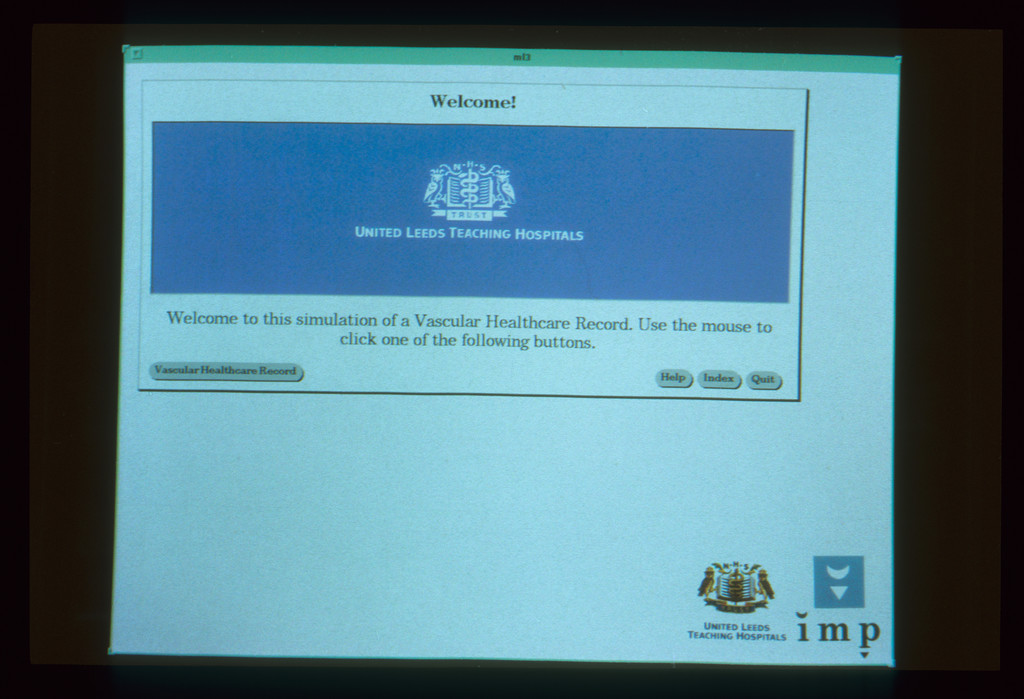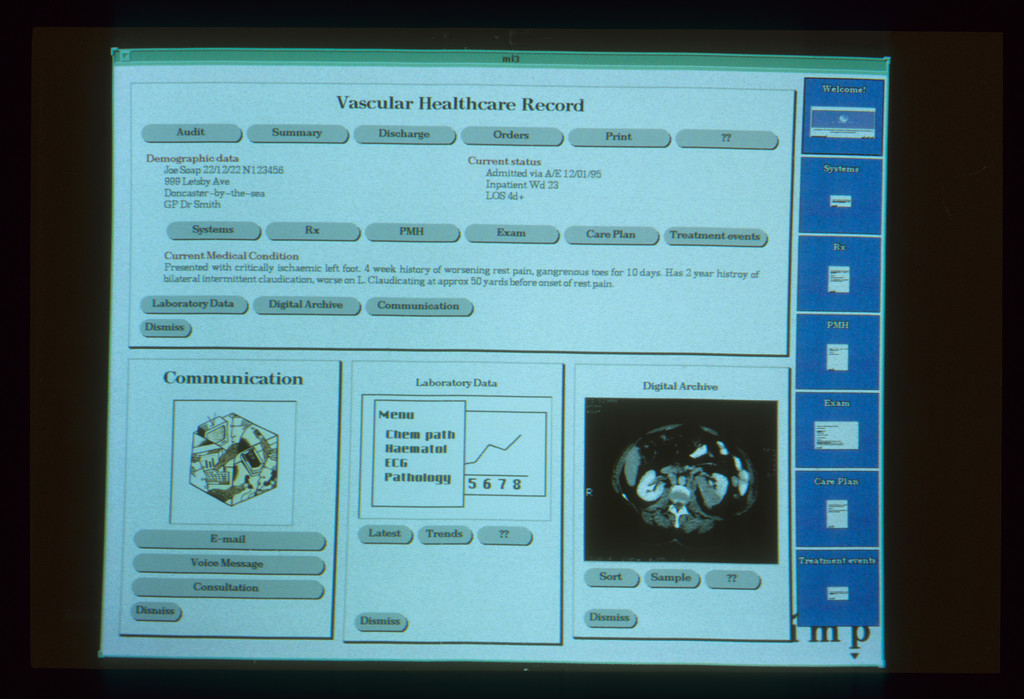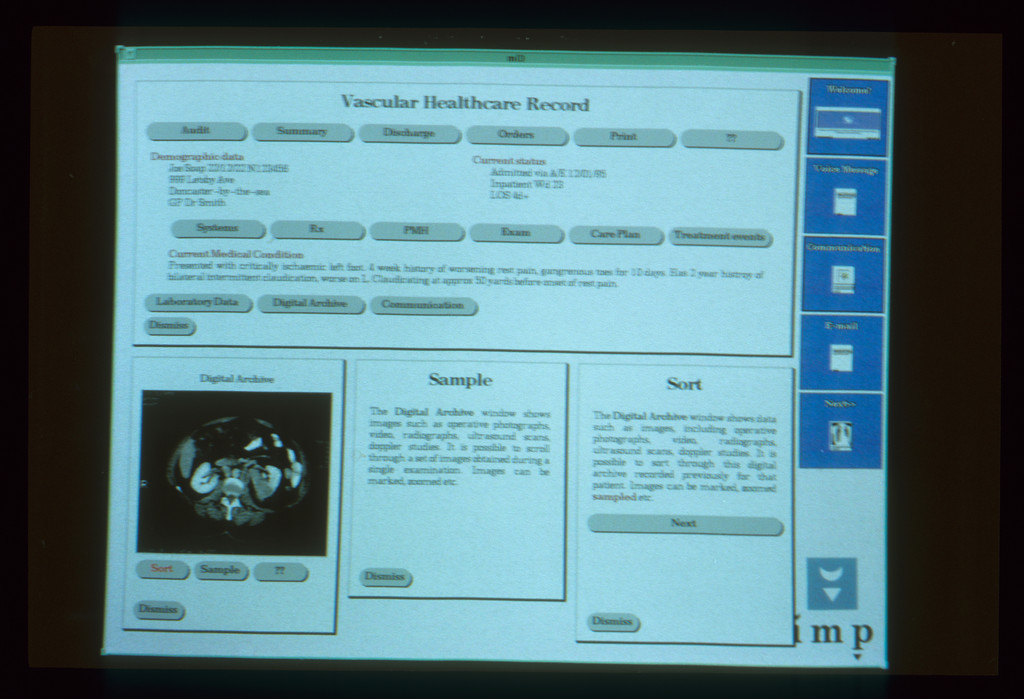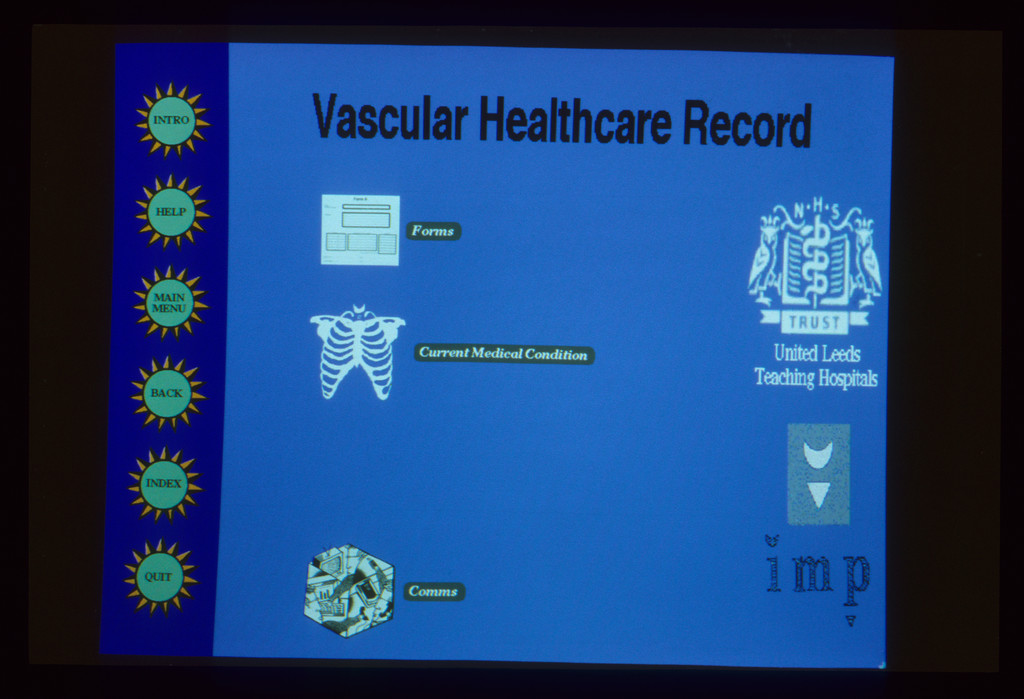IMP & The Department of Vascular Surgery, Leeds General Infirmary 1992
In 1990, IBM UK New Technologies Group at Hursley Park – back from IBM USA and charged with the fast track investigation of (what is) multimedia computing, and to deliver multimedia computing on their new generation of RT Workstations (running AIX Unix/X11 and with high resolutions colour displays) – found my vision, the HNS Browser concept demonstrator and my vision coincided nicely with their new mission and they funded the further development of my ideas regarding ‘information modelling’ and ‘interactive hypermedia’. This funding enable me to establish a small R&D Group which I called ‘IMP’ The Information Modelling Programme around a nucleus of a games programmer and games graphic artist.
The idea of computer-based multimedia and its potential applications became of considerable interest in the mid-1990s and became something of a bandwagon : where a rash of ‘Multimedia’ companies opened their doors in London; where the brochures were impressive and the promise (of multimedia software) was exciting BUT, as a senior technical analyst who followed my IMP project closely told me at the time : he had visited a number of these new Multimedia Consultancies in search of software beyond the hype, he had put his credit card on the table and asked for it to be swiped (price no object) and for the software to be put in a box – but his card was never swiped : there was no software!
Where as a part of the R&D Evolutionary Series of work on ‘Information Modelling’ and ‘Interactive Hypermedia’ – we worked with experts/practitioners in a variety of domains including Medicine. We developed a series of multimedia authoring tools. In 1990, we delivered the GPE Tool; in 1991/2, we delivered the Media Language Tool; and in 1993/4 we delivered the GARDEN Tool.
Where we suggested the concept of Information Systems to experts in various domains. We were not interested in developing individual hand crafted bespoke applications on proprietary platforms. The technical strategy we pursued was open systems, distribution on the network UNIX/X11 Windows, TCP-IP and object oriented software engineering.
We worked on a number of projects in the medical domain. In one of these, we worked with Mr Andrew Mavor Consultant Vascular Surgeon and his team at The General Infirmary at Leeds – to develop a Concept Demonstrator : ‘The Vascular Unit Information System’. Included in this project, and in consultation with real working clinicians (!) – we prototyped a number of designs for the Multimedia Healthcare Record
In 1992, I designed a generic GUI – including a number of generic modules which represented essential elements in the (hospital) medical practitioners domain : Communications Module; Diagnostic Tests Module; Medical Images Module; ETC). Where the concept was that a medical practitioner e.g. consultant, registrar, house officer, would enter the hospital – equipped with a software module/tool on a gadget (the gadget of the time e.g. at that time, smart card, today, usb stick etc) would plug in to the hospital network and the gadget/hospital information system would include a practitioner ID and log on to the institutional IT System, a patient list and associated medical record including all notes, data, test results (including images etc), an up to date treatment schedule and so forth.
The concept demonstrators of the Vascular Healthcare Record I designed and that we developed were based on a notion of a ‘framework tool’ for the medical practitioner for access to institutions and data resources and for inclusion of the patient record – including a number of standard generic modules e.g. an ID module, a communications module, patient record modules for clinical history, notes, diagnostic test results and images and access to institutional databases, a utilities module. The idea was that a medical practitioner would log in with the framework tool and proceed.

In 1992 and 1993, we created two alternative design simulations for the Vascular Healthcare Record were designed and tested with end users: ‘The White Queen’ and ‘The Red Queen’, employing our Media Language Tool and the GARDEN Tool.

This version of the Multimedia Healthcare Record (here the White Queen) was built with Media Language.
The Welcome Page – presented a ‘Chunk’ with 4 buttons : Buttons for Quit, Help and Index and a Button for The Vascular Health Care Record.

In Media Language – application information spaces (domain elements) were displayed in Chunks (a chunk was created in the Index and then automatically compiled as a Chunk). When elements of the Vascular Healthcare Record were selected e.g. Care Plan, Laboratory Data, Audit etc., currently displayed chunk(s) would be relegated to a History Strip (where chunks could be selected and re-displayed and a Browsable History Page compiled).
The Framework Design (and interface for the Clinician) included generic modules e.g Log In Module (where the clinician would/not be recognised and verified to enter an institution and download Current Patient List, Current Procedures List etc). Here the displayed Chunk : Communication, provided the clinician with a Communication Module – where the clinician could log on to her/his email etc., institution telephone system etc.

This version of the Multimedia Healthcare Record (here the Red Queen) was built with GARDEN.
GARDEN was a tool for authoring applications – including the customisable user interface and the interactivity and user feedback and the content. The GUI could be configured – simply and easily – from a template e.g. so that the background could be any image and the Framework Buttons e.g. Main Menu, Quit etc. could be of any graphical appearance (simply graphics files loaded into the Framework Button Template) and situated top, bottom, left or right; Applications Buttons e.g. Audit, Discharge – could be any image as graphic loaded into the Application Button Template – buttons organised into any arrangement as preferred.




The Index – was a generic display (the graphics sourced from a drawing of an old UK Government Civil Service Cardboard Card Index Drawer) where individual cards were labelled – elements form the application domain – and the Index browsed and elements could be separately located and displayed e.g. Laboratory Data.

